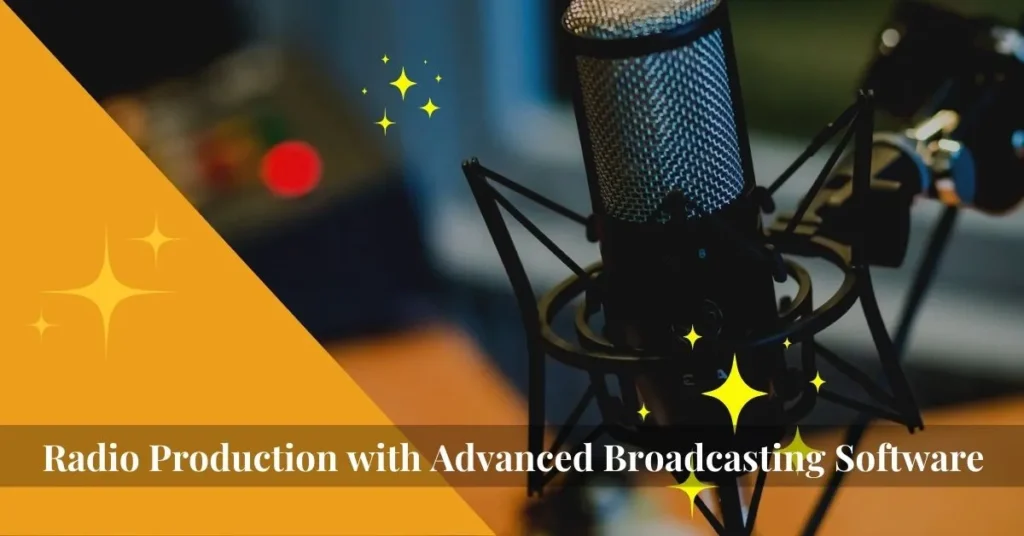If you’ve been curious about the behind-the-scenes magic of radio production, you might find it fascinating to discover the advancements in broadcasting software. The era of tapes and cumbersome equipment is now a thing of the past. Nowadays, radio producers rely on state-of-the-art technology to streamline their processes, boost creativity, and deliver top-notch content to their audience. In this article, we’ll delve into how cutting-edge broadcasting software is transforming the landscape of radio production.
Contents
- Enhancing Efficiency with Automated Functions
- Elevating Audio Excellence through Digital Processing
- Enhanced Collaboration through Cloud-Based Workflows
- Fostering Creativity with Virtual Studio Environments
- Seamless Integration with Social Media Platforms
- Optimizing Broadcast Delivery with Advanced Streaming Technology
- Analyzing Data for Informed Decision-Making and Audience Engagement
- Conclusion
Enhancing Efficiency with Automated Functions
Efficiency is crucial in an industry where time is at a premium. Advanced radio broadcasting software comes equipped with automated functions that enhance the efficiency of radio production workflows. These tools cover everything from scheduling and content management to audio editing and mixing, effectively reducing tasks and saving time.
The automation capabilities in scheduling allow producers to easily manage program slots and make adjustments to their timelines without hassle. Content management systems facilitate the storage and quick retrieval of multimedia elements like music tracks, sound effects, and commercials. By eliminating the need for searches through archives, producers can dedicate attention to creating compelling content.
Elevating Audio Excellence through Digital Processing
An important aspect of radio production revolves around ensuring top-tier quality output.
Cutting-edge broadcasting software offers signal processing features that enhance the quality of audio by minimizing background noise, optimizing volume levels, and improving overall clarity. These innovative algorithms analyze recordings in time and automatically make necessary adjustments.
Furthermore, these software solutions come equipped with equalizers, compressors, reverbs, and other effects that provide producers with enhanced control over-engineering. With a few clicks or tweaks of sliders, they can elevate audio into a professional-grade sound that captivates listeners’ ears.
Enhanced Collaboration through Cloud-Based Workflows
Collaboration plays a role in the success of radio production teams. Whether it involves coordination among on-air talent or communication with contributors and clients, seamless collaboration is crucial for delivering content.
Advanced broadcasting software fosters collaboration by offering cloud-based workflows that allow multiple users to work simultaneously on the project. It supports real-time editing, feedback sharing, and smooth file collaboration to ensure teamwork even when team members are located in different regions. Additionally, the cloud acts as a backup solution for files, minimizing the risk of data loss.
Fostering Creativity with Virtual Studio Environments
In recent times, radio producers have been limited by the constraints of their studios.
Today, modern broadcasting tools have evolved beyond setups, offering virtual studio environments that open up a world of possibilities. These virtual studios come with user interfaces that enable producers to organize audio tracks and effortlessly manage various aspects of their shows. They can easily incorporate music, sound effects, or snippets from episodes with a few clicks. The ability to experiment and preview changes instantly empowers producers to craft content quickly and efficiently.
Seamless Integration with Social Media Platforms
Integration with social media platforms is now a component of any media project. Advanced broadcasting software recognizes this necessity. Seamlessly integrates with platforms like Facebook, Twitter, and Instagram. Producers can easily share broadcasts or pre-recorded content across channels by incorporating these platforms within the software interface. This integration streamlines workflow efficiency by eliminating the need to switch between applications or devices to engage with audiences in time.
Optimizing Broadcast Delivery with Advanced Streaming Technology
Enhancements in streaming technology have revolutionized the delivery of broadcast content to listeners. Broadcasting software now includes features that enhance delivery and distribution processes, ensuring a listening experience for audiences.
Streaming technology enables radio stations to connect with audiences through a variety of platforms and devices, from FM/AM radios to streaming services and mobile apps. This versatility broadens the stations’ outreach, allowing them to tailor their content to suit the preferences of their listeners.
Analyzing Data for Informed Decision-Making and Audience Engagement
Analyzing data plays a role in making decisions and engaging with the audience in the media industry, particularly radio production. Advanced broadcasting software equips producers with analytics tools that offer insights into listener behavior and preferences.
Producers can determine which segments or shows resonate most with their audience by monitoring listening patterns, engagement metrics, and demographic data. This data guides programming decisions by highlighting content themes or talents while assessing audience interest in topics or genres.
Conclusion
As technology continues to advance, so does radio production. Modern broadcasting software provides radio producers with automation features that streamline workflows and enhance efficiency. With top-notch audio processing capabilities and virtual studio environments, they can transform recordings into compelling content with exceptional sound quality. Furthermore, collaborative tools facilitate teamwork among staff members regardless of their location.

